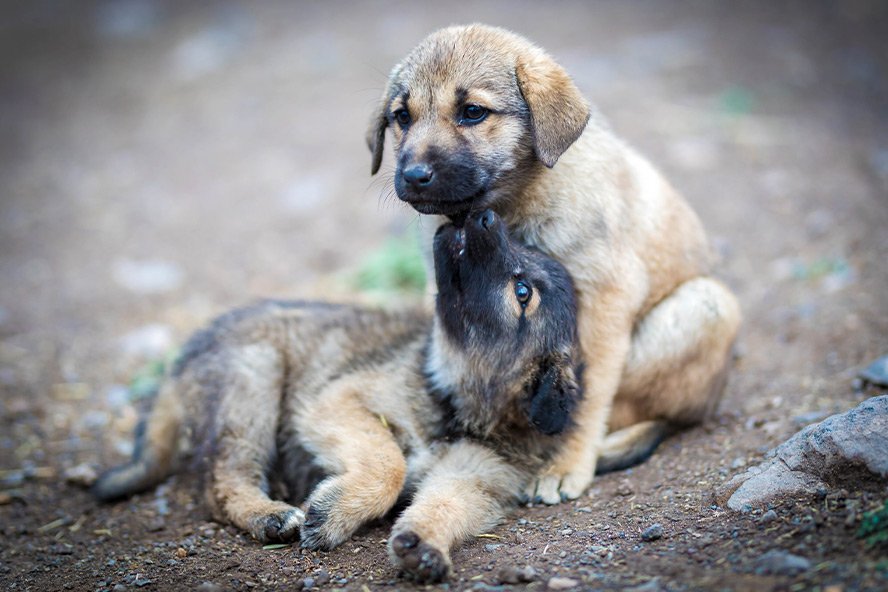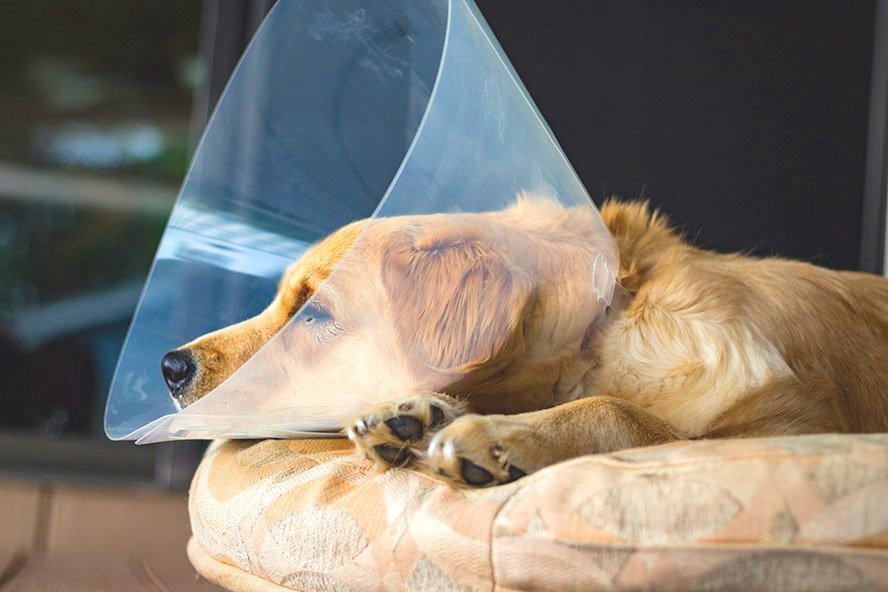cover: Soloviova Liudmyla | Shutterstock
Umbilical hernia in puppies. Your puppy is rolling onto its back and there you can see it: a small bump in the middle of the belly. This is most likely an umbilical hernia.
What do you do now? There are a few things to be aware of when you discover an umbilical hernia. This is because the bump can be more than just a cosmetic flaw and can even be life-threatening. We'll show you how vets can tell and guide you to do the test yourself. Then you'll know for sure what to do.
Do dogs really have a belly button?
Almost all mammals have a belly button, including our pets. The only exceptions are marsupials, i.e. kangaroos, koalas and the like.
The navel is the remnant of the umbilical cord, the connection between the embryo and the placenta. The blood vessels running through the umbilical cord supply the embryo in the womb with everything it needs to grow. At birth, this connection is severed and the navel remains as a scar. It lies on the midline halfway between the base of the ribs and the pelvis.
In most animals, the umbilicus is very small and inconspicuous and is hidden by the fur on the belly. If an umbilical hernia occurs, it suddenly becomes visible.
Alireza Zohoor | Unsplash
How does a puppy get an umbilical hernia?
When the navel heals after birth, the area where the umbilical vessels entered the body normally closes. In some dogs, this does not happen. Most umbilical hernias occur because of a genetic predisposition and are congenital. Rarely, however, the hernia can also result from an injury.
In any case, a small hole remains in the abdominal wall, called the hernial orifice. It is an entrance to the abdominal cavity. If it is big enough, fat and parts of the mesh or even the intestine can pass through. If you are wondering what the omentum is, it is a mobile structure in the abdominal cavity that looks like a net and covers the organs.
If you discover an umbilical hernia in your puppy, you should have a vet look at it. Together you can discuss what is best for your little one. Depending on the size, there are several options, from waiting to surgery.
When does an umbilical hernia need to be surgically repaired in puppies?
If the hole is so big that parts of the intestine can slip through, an operation is necessary. There is a danger of death due to the organs being trapped! Vets use a simple test to assess this. If you dare, you can try it yourself and palpate the hernia. The bump is usually round, soft and painless to the touch.
This is the best way to palpate: Press lightly on the bump with two fingers from above. You will first feel the skin, then the soft contents of the so-called hernia sac and underneath the abdominal wall with the hole. If the hole is only a few millimetres wide, the hernia is not dangerous and in most cases does not need to be treated surgically.
However, if you can feel a hole that is one or two fingers wide, there is a risk of the intestine becoming trapped. At this size, you can often carefully push the contents of the hernia back through the hole into the abdominal cavity. If the hernial orifice is wider than two fingers, the intestine will also fall through, but it will not get trapped. In both cases, the umbilical hernia should be closed surgically.
The best time for an operation depends on a number of circumstances. It is best to discuss this with your vet. Often, umbilical hernia surgery is done at the same time as neutering, which is planned anyway. As the predisposition for umbilical hernias is inherited, you should consider whether you should breed with affected animals. If a piece of intestine gets stuck, an emergency operation has to be performed. You can recognise this by the fact that the hernia suddenly becomes hard, swollen, changes colour or becomes painful.
Artur Tumasjan | Unsplash
Can also a patch help?
Before a surgery can be performed, it is advisable to wait until at least 8 weeks of age. The hernia will often shrink or close by then. You can even use a simple trick to prevent your puppy from developing a lump. It's best to have your vet show you how to do this the first time you bring your puppy in for a health check.
The trick is to use a patch with a button or coin. You must first gently push the contents of the umbilical hernia back into the abdomen. Then you tape a large button or coin with a patch over the umbilicus. The patch should be a bandage that sticks all the way around so that the button or coin cannot fall out and be swallowed. The pressure on the hernia keeps the fat or omentum in the abdominal cavity while the hole reduces in size. Change the patch regularly, especially if it gets dirty or wet.
How much does umbilical hernia surgery in puppies cost?
The costs for veterinary services in Germany are based on the German Fee Schedule for Veterinarians (Gebührenordnung für Tierärzte, GOT). Here, a range is listed within which various items may be charged. It depends on the method and the amount of work involved. If the hole is small, it is simply sewn up. If it is larger, however, a mesh must be used to stabilise it. Then there are the drugs and anaesthetics used, which can vary widely in price. And finally, the costs are higher if a castration is also performed in the same surgery or if it is an emergency operation in which part of the trapped intestine has to be removed.
The surgical closure of an uncomplicated umbilical hernia costs approximately between 250 € and 500 € net. In the past, such operations were generally excluded from animal health insurances. This is no longer the case and some insurers will cover the costs. It's best to find out beforehand.
By the way: If you buy a puppy that has an umbilical hernia, this is considered a defect and you can ask the breeder for a price reduction.
Kyla Metzker | Shutterstock
Can an umbilical hernia have long-term consequences?
Very few dogs with umbilical hernia suffer from long-term effects. But they do occur. The risk increases if the hole is very large. Then it can happen that it is not stable enough after the operation and opens again due to strong movement, overweight, an advanced pregnancy or birth.
If a piece of trapped, already necrotic intestine had to be removed during the operation of the umbilical hernia, it usually takes much longer for the affected dog to recover. Even other internal organs can be damaged by a circulatory shock triggered by this. In an uncomplicated operation, only the wound on the navel needs to heal, which usually takes two to three weeks. Your dog will be fit again after sleeping off the anaesthetic.
Conclusion
If your puppy has an umbilical hernia, you can check for yourself to see if it is a high-risk hernia. You should then show it to your vet at the next check-up at the latest.
Often there is nothing to be done or a minor surgery will be performed when your dog is older. In any case, keep a close eye on the umbilical hernia and do not hesitate to act if it becomes hard, suddenly swollen, changes colour or becomes painful.
The confidu magazine is written by our veterinarians according to current scientific standards. The articles do not replace a veterinary diagnosis, but are intended to provide you with initial information on many topics related to your animal. If you have specific questions about your pet, our vets will be happy to advise you via the confidu app.








